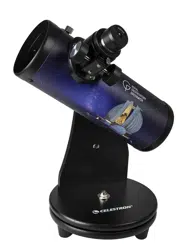Loading ...
Loading ...
Loading ...

8 | ENGLISH
If you are going to be observing deep-sky objects, such as
galaxies and nebulae, you should consider traveling to a
dark sky site away from city lights and upwind of any major
source of air pollution, with a relatively unobstructed view of
the horizon. Always choose as high an elevation as possible
to lower the effects of atmospheric instability and ensure
that you are above any ground fog.
While it can be desirable to take your telescope to a dark
sky site, it is not always necessary. If you plan to view the
planets, the Moon or even some of the brighter deep-sky
objects, your own backyard is a perfect location. Set up the
scope out of the direct path of streetlights or house lights
to help protect your night vision. Try to avoid observing
anything that lies within 5 to 10 degrees over the roof of a
building. Roofs absorb heat during the day and radiate this
heat out at night, causing a layer of turbulent air directly
over the building that can degrade your image.
Observing through a window is not recommended because
the window glass will distort images considerably. And
an open window can be even worse, because warmer
indoor air will escape out the window, causing turbulence.
Astronomy is an outdoor activity.
Try not to view immediately after sunset. After the Sun goes
down, the Earth is still cooling, causing air turbulence.
As the night goes on, not only will seeing improve, but air
pollution and ground lights will often diminish. Some of
the best observing time is often in the early morning hours
before dawn.
Objects are best observed as they cross the meridian, the
imaginary line that runs from north to south through a point
directly over your head. This is the point at which objects
reach their highest points in the sky and your telescope is
looking through the least amount of atmosphere possible.
Objects that are rising or setting near the horizon will suffer
more atmospheric turbulence since you are looking through
a much longer column of air. It is not always necessary
to have cloud-free skies if you are looking at planets
or the Moon. Often broken cloud conditions provide
excellent seeing.
Allowing your telescope to acclimate to outdoor
temperatures minimizes heat wave distortion inside the
telescope tube. Give your telescope at least 10 minutes to
cool down to outside air temperature, or longer if there is
a big difference between the temperature of the telescope
and the outside air.
SELECTING AN OBSERVING SITE
CHOOSING THE BEST TIME TO OBSERVE
COOLING THE TELESCOPE
TIPS FOR ASTRONOMICAL OBSERVING
If you are planning to observe deep sky objects, allow
your eyes to fully adapt to the dark by avoiding exposure
to white light sources such as flashlights, car headlights,
and streetlights. It will take your pupils about 30 minutes
to expand to their maximum diameter and build up the
levels of optical pigments necessary to see the faint light
from a distant target. If you need light to help set up your
telescope, try using a red LED flashlight at a low brightness
setting and avoid looking straight at the light source.
When observing, it is important to observe with both eyes
open. This avoids eye fatigue at the eyepiece. If you find
this too distracting, cover the unused eye with your hand
or an eye patch. The center of your eye works well in bright
daylight, but is the least sensitive part of the eye when
trying to see subtle detail at low light levels. When looking
in the eyepiece for a faint target, don’t look directly at it.
Instead look toward the edge of the field of view and the
object will appear brighter.
ADAPTING YOUR EYES
NORTH SOUTH
Loading ...
Loading ...
Loading ...
